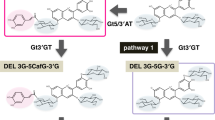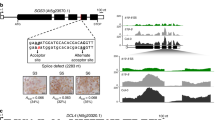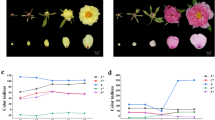Abstract
Anthocyanins are red and violet pigments that color flowers, fruits and epidermal tissues in virtually all flowering plants. A single order, Caryophyllales, contains families in which an unrelated family of pigments, the betalains, color tissues normally pigmented by anthocyanins1. Here we show that CYP76AD1 encoding a novel cytochrome P450 is required to produce the red betacyanin pigments in beets. Gene silencing of CYP76AD1 results in loss of red pigment and production of only yellow betaxanthin pigment. Yellow betalain mutants are complemented by transgenic expression of CYP76AD1, and an insertion in CYP76AD1 maps to the R locus2,3 that is responsible for yellow versus red pigmentation. Finally, expression of CYP76AD1 in yeast verifies its position in the betalain biosynthetic pathway. Thus, this cytochrome P450 performs the biosynthetic step that provides the cyclo-DOPA moiety of all red betacyanins. This discovery will contribute to our ability to engineer this simple, nutritionally valuable pathway4 into heterologous species.
This is a preview of subscription content, access via your institution
Access options
Subscribe to this journal
Receive 12 print issues and online access
$209.00 per year
only $17.42 per issue
Buy this article
- Purchase on Springer Link
- Instant access to full article PDF
Prices may be subject to local taxes which are calculated during checkout




Similar content being viewed by others
Accession codes
Primary accessions
NCBI Reference Sequence
References
Clement, J.S. & Mabry, T.J. Pigment evolution in the Caryophyllales: a systematic overview. Bot. Acta 109, 360–367 (1996).
Keller, W. Inheritance of some major color types in beets. J. Agric. Res. 52, 27–38 (1936).
Goldman, I.L. & Austin, D. Linkage among the R, Y and BI loci in table beet. Theor. Appl. Genet. 100, 337–343 (2000).
Stintzing, F.C. & Carle, R. Functional properties of anthocyanins and betalains in plants, food, and in human nutrition. Trends Food Sci. Technol. 15, 19–38 (2004).
Christinet, L., Burdet, F.X., Zaiko, M., Hinz, U. & Zryd, J.-P. Characterization and functional identification of a novel plant 4,5-extradiol dioxygenase involved in betalain pigment biosynthesis in Portulaca grandiflora. Plant Physiol. 134, 265–274 (2004).
Steiner, U., Schliemann, W., Bohm, H. & Strack, D. Tyrosinase involved in betalain biosynthesis of higher plants. Planta 208, 114–124 (1999).
Schliemann, W., Kobayashi, N. & Strack, D. The decisive step in betaxanthin biosynthesis is a spontaneous reaction. Plant Physiol. 119, 1217–1232 (1999).
Vogt, T., Grimm, R. & Strack, D. Cloning and expression of a cDNA encoding betanidin 5-O-glucosyltransferase, a betanidin- and flavonoid-specific enzyme with high homology to inducible to inducible glucosyltransferases from the Solanaceae. Plant J. 19, 509–519 (1999).
Sasaki, N., Adachi, T., Koda, T. & Ozeki, Y. Detection of UDP-glucose: cyclo-DOPA 5-O-glucosyl-transferase activity in four o'clocks (Mirabilis jalapa L.). FEBS Lett. 568, 159–162 (2004).
Goldman, I.L. A list of germplasm releases from the University of Wisconsin Table Beet Breeding Program, 1964–1992. HortScience 31, 880–881 (1996).
Guengerich, F.P. Common and uncommon cytochrome P450 reactions related to metabolism and chemical toxicity. Chem. Res. Toxicol. 14, 611–650 (2001).
Kim, J. H. et al. Metabolism of benzo[a]pyrene and benzo[a]pyrene-7,8-diol by human cytochrome P450 1B1. Carcinogenesis 19, 1847–1853 (1998).
Liu, Y., Schiff, M. & Dinesh-Kumar, S.P. Virus-induced gene silencing in tomato. Plant J. 31, 777–786 (2002).
Lewellen, R.T. Registration of Rhizomania resistant, monogerm populations C869 and C869CMS sugarbeet. Crop Sci. 44, 357–358 (2004).
Koncz, C. & Schell, J. The promoter TL-DNA gene 5 controls the tissue-specific expression of chimaeric genes carried by a novel type of Agrobacterium vector. Mol. Gen. Genet. 204, 383–396 (1986).
Zhao, M., Morohashi, K., Hatlestad, G., Grotewold, E. & Lloyd, A. The TTG1-bHLH-MYB complex controls trichome cell fate and patterning through direct targeting of regulatory loci. Development 135, 1991–1999 (2008).
Karimi, M., Inze, D. & Depicker, A. GATEWAY vectors for Agrobacterium-mediated plant transformation. Trends Plant Sci. 7, 193–195 (2002).
Quandt, H.J., Pühler, A. & Broer, I. Transgenic root nodules of Vicia hirsuta: a fast and efficient system for the study of gene expression in indeterminate-type nodules. Mol. Plant Microbe Interact. 6, 699–706 (1993).
Kugler, F., Stintzing, F.C. & Carle, R. Identification of betalains from petioles of differently colored Swiss chard (Beta vulgaris L. ssp. cicla (L.) Alef. Cv. Bright Lights) by high-performance liquid chromatography–electrospray ionization mass spectrometry. J. Agric. Food Chem. 52, 2975–2981 (2004).
Bilyk, A. Thin layer chromatographic separation of beet pigments. J. Food Sci. 46, 298–299 (1981).
Van Mullem, V., Wery, M., De Bolle, X. & Vandenhaute, J. Construction of a set of Saccharomyces cerevisiae vectors designed for recombinational cloning. Yeast 20, 739–746 (2003).
Urban, P., Mignotte, C., Kazmaier, M., Delorme, F. & Pompon, D. Cloning, yeast expression, and characterization of the coupling of two distantly related Arabidopsis thaliana NADPH–cytochrome P450 reductases with P450 CYP73A5. J. Biol. Chem. 272, 19176–19186 (1997).
Acknowledgements
The authors dedicate this manuscript to Tom Mabry and thank him for inspiration. The authors thank K. Keller for help with pigment analysis. This work was supported by USDA grant 2008-01111 and US National Science Foundation (NSF) grant MCB-1122179.
Author information
Authors and Affiliations
Contributions
G.J.H., R.M.S., N.A.A., A.G. and A.M.L. performed experiments. G.J.H., R.M.S. and A.M.L. wrote the paper. I.L.G., J.M.M., G.J.H., R.M.S. and A.M.L. helped conceive of the project, analyze data and edit the manuscript. I.L.G. and J.M.M. contributed critical resources and reagents.
Corresponding author
Ethics declarations
Competing interests
I.L.G. has a financial interest in PhytoColorants, LLC, which is involved in developing natural commercial food colors from sources such as beet.
Supplementary information
Supplementary Text and Figures
Supplementary Table 1 and Supplementary Figures 1–4 (PDF 412 kb)
Rights and permissions
About this article
Cite this article
Hatlestad, G., Sunnadeniya, R., Akhavan, N. et al. The beet R locus encodes a new cytochrome P450 required for red betalain production. Nat Genet 44, 816–820 (2012). https://doi.org/10.1038/ng.2297
Received:
Accepted:
Published:
Issue Date:
DOI: https://doi.org/10.1038/ng.2297
This article is cited by
-
Genetic diversity and genome-wide association study of 13 agronomic traits in 977 Beta vulgaris L. germplasms
BMC Genomics (2023)
-
Betalain biosynthesis in red pulp pitaya is regulated via HuMYB132: a R-R type MYB transcription factor
BMC Plant Biology (2023)
-
Betalains Alleviate Exercise-Induced Oxidative Stress, Inflammation, and Fatigue and Improve Sports Performance: an Update on Recent Advancement
Current Nutrition Reports (2023)
-
BpCYP76AD15 is involved in betaxanthin biosynthesis in bougainvillea callus
Planta (2023)
-
Transcriptome analyses shed light on floral organ morphogenesis and bract color formation in Bougainvillea
BMC Plant Biology (2022)



